20 Mind-Blowing Products At The Intel Developer Forum
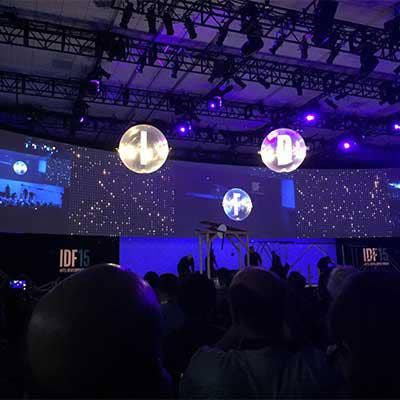
From PC To 5G
From dancing robots to smart vending machines, Intel showed the futuristic ripples in the tech industry that its newest products are making this week at the Intel Developer Forum 2015.
The Santa Clara, Calif.-based company, a longtime traditional player in the PC market, shunned desktops at this year's San Francisco conference, instead playing up cool new form factors and technology surrounding Internet of Things, sensitization and personalized experiences.
"Now [today's world] is expanding to include more human-like sensors, providing new and immersive experiences for users," said CEO Brian Krzanich during his keynote speech.
Following are 20 cool products, developed both by Intel and by developers utilizing Intel's technology, at this year's IDF.
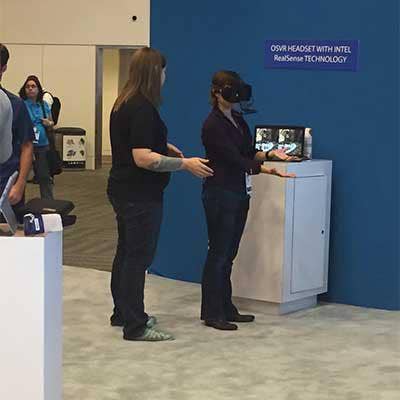
OSVR Headset
Razer, a gaming hardware manufacturer that promotes the open-source virtual reality (OSVR) ecosystem through its open platform dev kit, showed off its virtual reality headset at IDF.
Users strap the headset over their faces, and the OSVR framework allows them to enter a 3-D virtual world.
Intel's RealSense technology adds another layer of reality as users are able to reach out in the virtual space and move objects with their own hands. The RealSense 3-D camera works by understanding sensory input and movement-supported platforms.
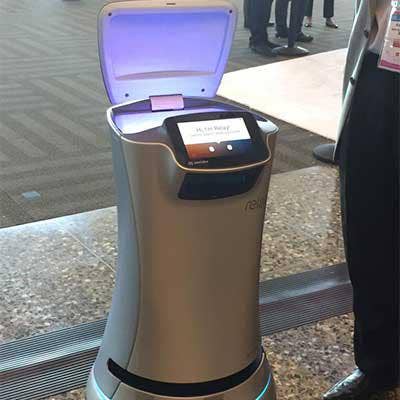
Savioke's Robot Butler
Savioke's robot butler, Relay, also made an appearance on the IDF technology floor. Savioke is a Santa Clara, Calif.-based company that specializes in robotic solutions for the hospitality industry.
Three-foot-tall Relay is already on the market, working in Crowne Plaza hotels as a delivery machine to bring hotel guests food, drink or anything else they may need.
Utilizing Intel's RealSense technology, Relay is able to carry items in its top compartment from hotel desks to the room that is programmed into it. Once at the room, the small robot will alert guests that it is there, open its compartment for guests to take their items, and ask how their stay is doing.
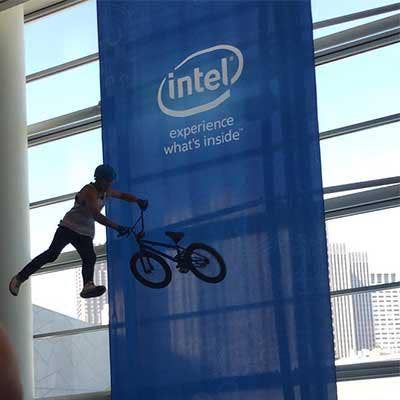
Sensor-Equipped BMX Bikes
Intel showed off how its Internet of Things-targeted SoC platform, Curie, was opening new possibilities with sports -- specifically, BMX (bicycle motocross).
Curie sensors attached to bikes can help create real-time pictures of bikes and other athletic tools while they are in motion, helping athletes to get a better sense of how they can improve on their athletic skills.
For instance, data from a BMX trick called "Foot Jam Tail Spin" will show up on compute devices, where the trick can be identified and evaluated.
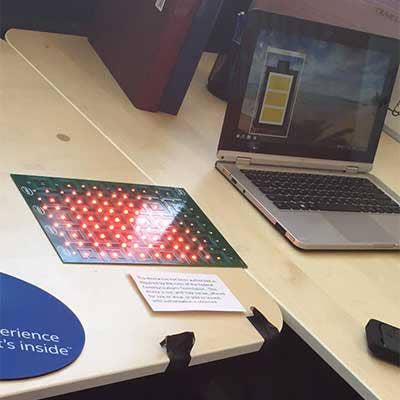
Intel Wireless Charging
Intel showed demonstrations of wireless gigabit technology, first unveiled a year ago at IDF, which enables cable-free device charging. The wireless charging capability, which is based on Rezence technology, a wireless charging standard, can fit under surfaces so that users can place their multiple devices onto tables in order to charge them.
Wireless charging is part of the cordless ecosystem Intel wants to promote through its new sixth-generation 14nm Skylake architecture. In addition to wireless charging technology, Intel has also been promoting its wireless docking and wireless display technology.
According to Intel, these wireless charging capabilities will appear in devices starting next year.
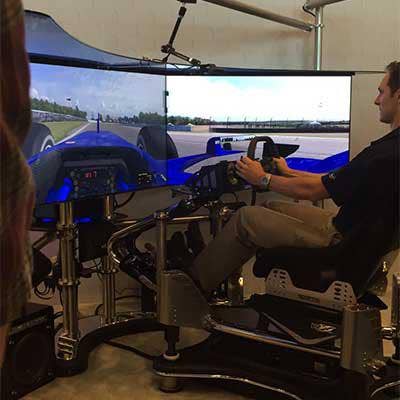
VRX Advanced Simulators iRacing
VRX advanced simulators iRacing sensors create an immersive driving game experience through a series of technologies, including Intel's RealSense Technology for head tracking, and Intel's sixth-generation Core processors.
The hardware simulator creates an ultra-realistic driving simulation experience, so users feel as though they are actually speeding down the raceway. This immersive experience includes Dolby 5.1 surround sound, a professional racing wheel and pedals, four full motion actuators, and an ultra-HD triple screen array.
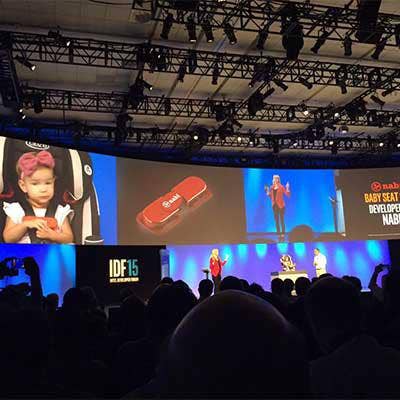
Nabi Car Seat Clip
During CEO Brian Krzanich's keynote speech at IDF, one Internet of Things application that developer Nabi showed off was the Nabi car seat clip. This clip harnesses a child into the seat, but it is also designed for a more intensive purpose -- making sure that babies aren't left in the sweltering heat of locked cars unintentionally.
Sensors on the clip detect when it is strapped on and alerts users on their phones when they walk away from the car without unstrapping their children.
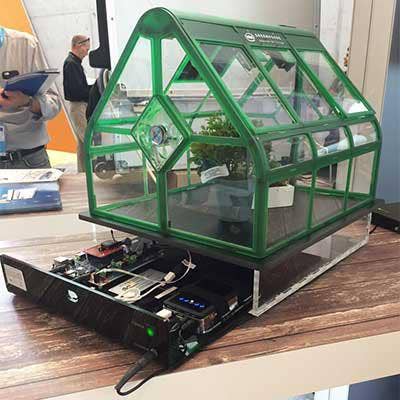
Smart Greenhouse Solution Platform
Another industrial use for the Internet of Things is the agricultural vertical, where Intel has taken steps to increase efficiency through its IoT gateway products.
This solution uses sensors for temperature, humidity, pH, and other data that are pulled into Intel's Atom processor-based gateway. This data then passes through a Wind River EMS portal and is uploaded into the cloud system.
The system will work to turn on fans or sprinklers or open windows if the heat becomes too much.
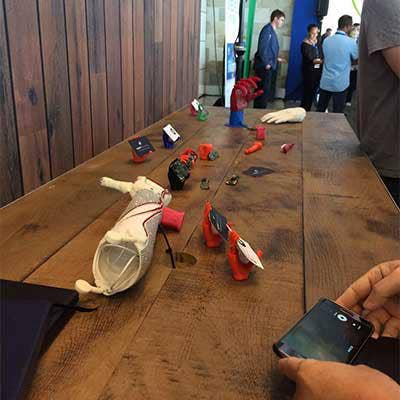
Bionic Arms
Open Bionics showed off its portfolio of bionic arms and hands at Intel Developer Forum. The company developed low-cost, modular prosthetic hands for amputees by using an anthropomorphic kinematic model and bio-inspired finger actuation and transmission system, along with Intel technology.
Open Bionics was a finalist in Intel's 2014 wearables contest for the best low-cost bionic hands category.
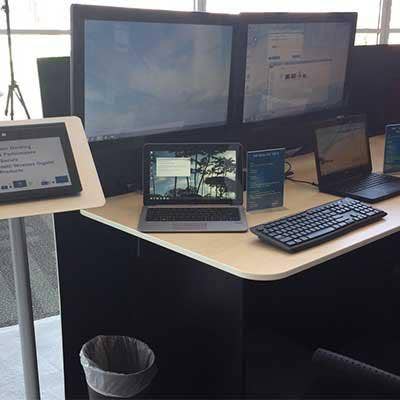
Automatic Docking
In addition to wireless charging features for enterprise customers, Intel also showed off its innovations with automatic docking.
Automatic docking is powered by Intel's Wireless Gigabit products, which are intended to ensure for automatic docking between products like Hewlett-Packard's Elite X2-1011 device and the monitor.
When the users walk away from the wireless dock holding their portable notebooks or tablets, for example, the monitor will automatically become disconnected. This feature enforces security in the workplace.
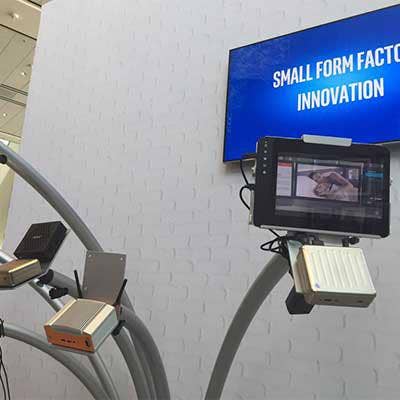
Mini PCs
Intel showed off its variety of new small form factors beyond traditional desktops, displaying "all the power without the tower," according to Intel.
These Mini PCs contains the performance of desktop towers in an ultra-small form factor. One of Intel's more popular small form factors, the NUC, runs on a fifth-generation Intel Core i5 vPro processor, contains 16 GB of memory, and uses Intel HD Graphics 5500.
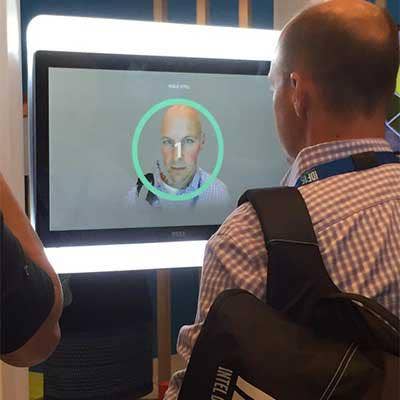
3D Systems Virtual Characters
3D Systems showed off how it can utilize Intel's RealSense Technology to virtually incorporate real-life physical features of the user into video games.
RealSense Technology, which features spacial and movement recognition to gain a sense of the physical facial features of the user, can then incorporate these features into a video game or into a 3-D-printed statue design.
3D Systems' new virtual character technology plays into Intel's trajectory of personalizing the gaming and enthusiast industry.
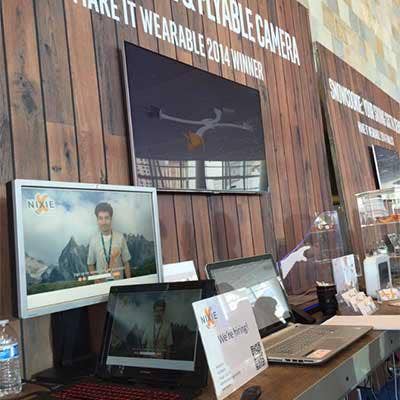
Nixie Flyable Selfie Camera
In an age where selfie sticks and GoPro cameras are reinventing how photographs are taken, Nixie threw its hat into the ring with the Nixie Flyable Camera.
This camera is attached to a band that can strap on the wrist, but doubles as a boomerang that will take users' 1080p photos or video and fly back to them. At the core of this handy little device is an Intel Edison system on a chip.
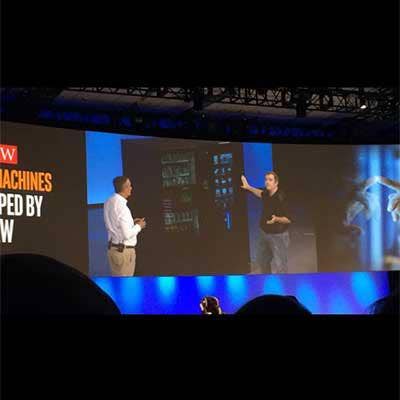
Smart Vending Machine
Developer N&W's "vending machine of the future" merges the digital and physical world as part of the Internet of Things.
The vending machine contains business intelligence that collects the user's gender and age demographic. This data helps tailor the machine to the customer and allows the vending machine manufacturers to assess these demographics for go-to-market strategies.
These vending machines use an integrated RealSense Camera so users can engage with the machines without having to touch the screen directly. Users can also utilize applications from their mobile devices to interact with the vending machines.
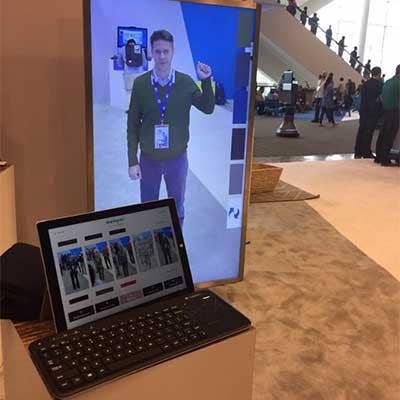
MemoMi Memory Mirror
The Intel Core i7 processor with Iris GPU powers the MemoMi Memory Mirror, a fitting room mirror that allows customers to try on clothes digitally.
This 65-inch, commercial-grade mirror, which will be featured in up to 16 Neiman Marcus stores in the fall, allows customers to get a 360-degree view on themselves while trying on clothes, and allows them to see previous clothes they tried on for comparison. The mirror also promotes customer engagement through allowing customers to promote hot items through social media and share their favorite outfits with friends.
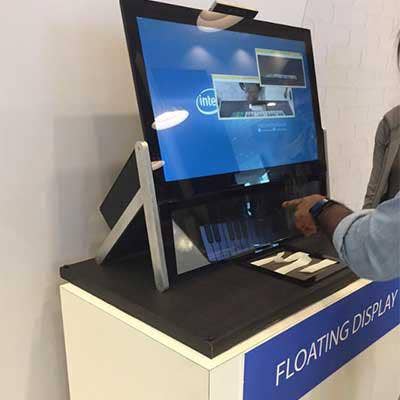
Floating Display
Toward the end of Krzanich's keynote, Intel showed off its next big futuristic technology: floating displays.
These 3-D air interfaces, not dissimilar to holographic displays in futuristic movies, use RealSense so users can connect to the visual display of a Creative camera with movement recognition technology.
In a more industrial ecosystem, Intel's proof of concept floating displays can be utilized in a medical setting, where users don't want to touch physical screens and spread germs.
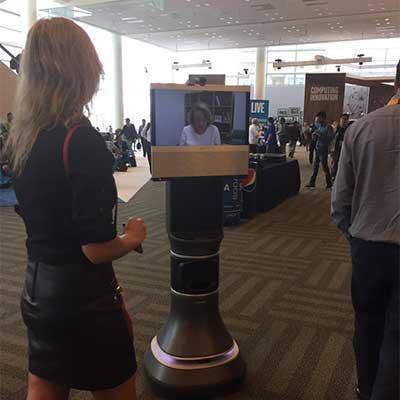
IRobot
Intel showed off an iRobot AVA 500 video collaboration robot, a machine that is hooked up to video conferencing tools and can move around.
This robot is also equipped with Intel RealSense cameras to support the platform's ability to navigate and avoid obstacles while moving around the room. With the iRobot video collaboration tool, users can video conference with one another and move around the room.
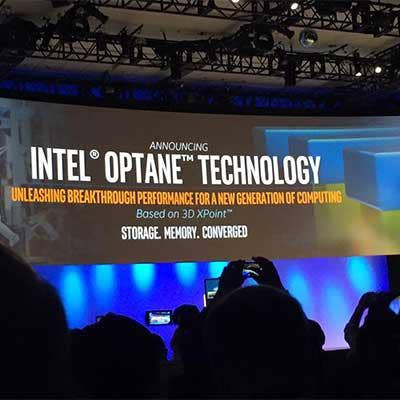
Intel Optane Technology
At IDF, Intel unveiled Intel Optane Technology, which will combine the company's system memory controller, interface hardware and software IP with its new 3-D XPointTM nonvolatile memory media.
This technology will come to market in 2016 through a new line of high-endurance, high-performance SSDs, said Intel.
In addition to solid state drives, this new technology will also power a line of Intel dual in-line memory modules (DIMM) for Intel's next-generation data center platforms.
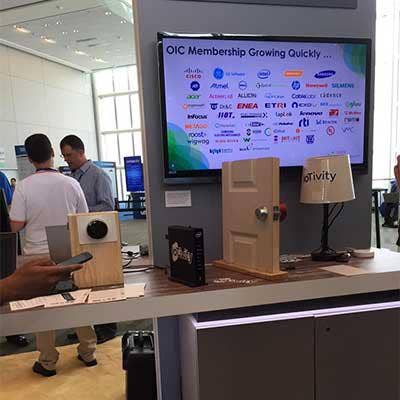
Open Interconnect Consortium
Open Interconnect Consortium, an industry group delivering Internet of Things connectivity, is an emerging standards specification for IoT. While the IoT market has many individual solutions, OIC connects these solutions so that they interoperate.
OIC works toward building a smarter home for users. With OIC code, users can send action commands to their end devices and group together different devices. For instance, when a lamp in a home is turned off, the user can program their home so that their house thermometer will automatically turn down as well.
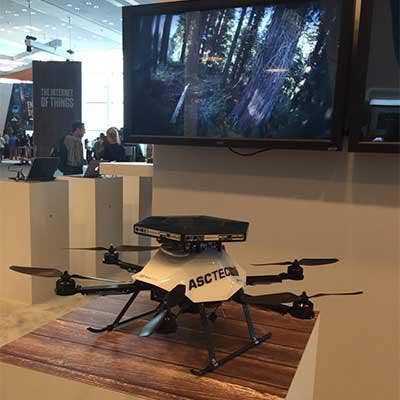
AscTec Firefly
Ascending Technologies, a developer and manufacturer of civil drones, made an appearance at Intel Developer Forum to show off its AscTex Firefly drone. This hexacopter runs on an Intel Core i7 processor and uses six Intel RealSense cameras for depth sensors.
The AscTec Firefly drone contains low-noise, energy-efficient engines that work with 100 watts per motor, and a six-rotor propulsion system. The Firefly and Ascending Technologies' other drones are designed to offer high-tech flight systems with solutions for full-service potential both indoors and outdoors.
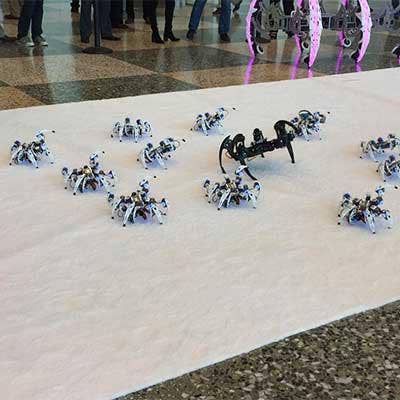
Dancing Hexabots
Intel celebrated its Intel Developer Forum by displaying a swarm of dancing robot spiders, or "hexabots." Hexabots, which run on the Intel Edison board and are capable of being powered by the Intel Curie platform, were inspired by Chrysina, or jewel scarabs.
Hexabots are brightly colored and have been programmed to showcase light effects, move quickly and display a few limited swarm behaviors, according to Intel.